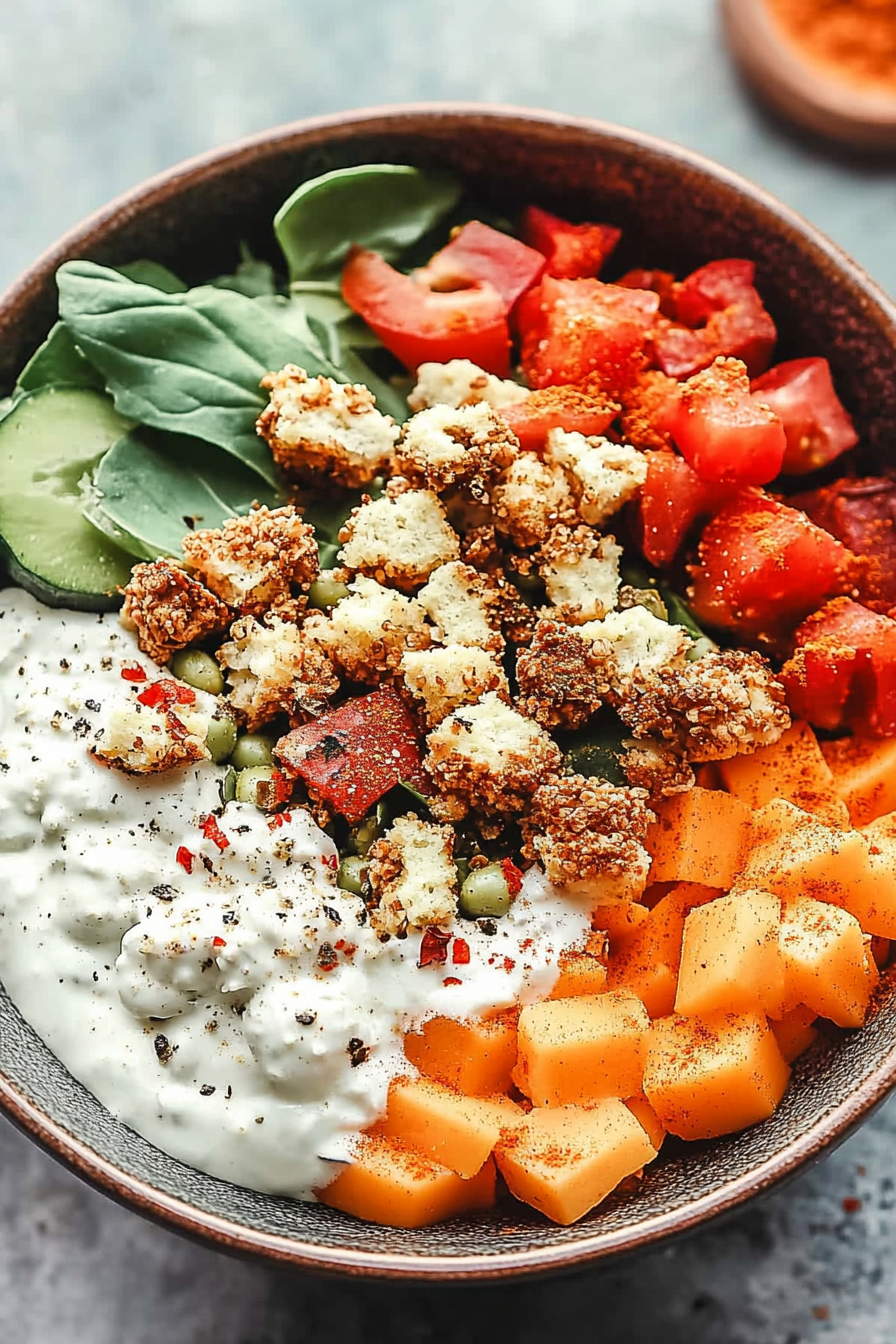Mastering buddha bowl :Tips and Techniques
Buddha bowls are a vibrant and nutritious meal option that combines fresh, cooked, and fermented ingredients into one colorful dish. This recipe shines because it is simple to prepare, packed with wholesome nutrients, and easily adaptable to different dietary preferences including vegan and gluten-free diets. The mix of roasted sweet potatoes, crisp radishes, shredded red cabbage, and sautéed chickpeas creates a delightful balance of textures and flavors that awaken the palate.
One of the biggest advantages of this buddha bowl recipe is its flexibility. You can switch out ingredients like rice for quinoa, or chickpeas for other legumes based on availability or taste preference. Adding sauerkraut not only introduces a tangy fermented twist but also a boost of probiotics that support digestion. For seasoning, massaging kale with lemon juice tenderizes the greens and adds a fresh zing, making the dish even more refreshing.
The quick roasting of sweet potatoes at 400 degrees Fahrenheit results in a perfect softness with a subtle caramelization that complements the earthy flavors of the legumes. Preparing a homemade turmeric tahini sauce adds a creamy, slightly spicy element that ties all the components together beautifully.
This buddha bowl is ideal for those looking for a balanced meal that requires minimal hands-on time, making it perfect for busy home cooks or anyone seeking a healthy, plant-based option.
Benefits and Advantages of buddha bowl
Why This Recipe Stands Out
This buddha bowl recipe is particularly effective because it blends nutrition, flavor, and ease of preparation seamlessly. It offers a balanced mix of complex carbohydrates from sweet potatoes and brown rice or quinoa, plant-based protein from chickpeas, and healthy fats from olive oil and tahini sauce. The inclusion of fermented foods like sauerkraut supports gut health, making it nourishing beyond basic nutrients.
From a practical standpoint, this recipe is straightforward to make within 35 to 40 minutes, suitable for cooks of all skill levels. Roasting vegetables and massaging kale are simple techniques that enhance flavors without requiring specialized kitchen skills or equipment.
Health Benefits
- Rich in Fiber: The combination of brown rice/quinoa, legumes, and vegetables supports digestive health and keeps you feeling full longer.
- Plant-Based Protein: Chickpeas and seeds provide essential amino acids, making this a great protein source for vegans and vegetarians.
- Antioxidants and Vitamins: Sweet potatoes contain beta-carotene and vitamin C, while kale and cabbage contribute vitamins K, A, and folate.
- Gut-Friendly Fermentation: Sauerkraut delivers probiotics that help maintain a healthy microbiome.
Another advantage of this bowl is its versatility as a meal prep option. Ingredients can be cooked ahead of time and assembled just before eating to save even more time during the week.
Moreover, the vibrant colors and textures make it visually appealing and enjoyable to eat, increasing the likelihood that even picky eaters will appreciate it. Learning to prepare such a well-rounded bowl can be a stepping stone to adopting more plant-based meals within your diet.
For more ideas on quick wholesome meals, check out the Shrimp and Cucumber Salad Recipe, another simple and nutritious dish.
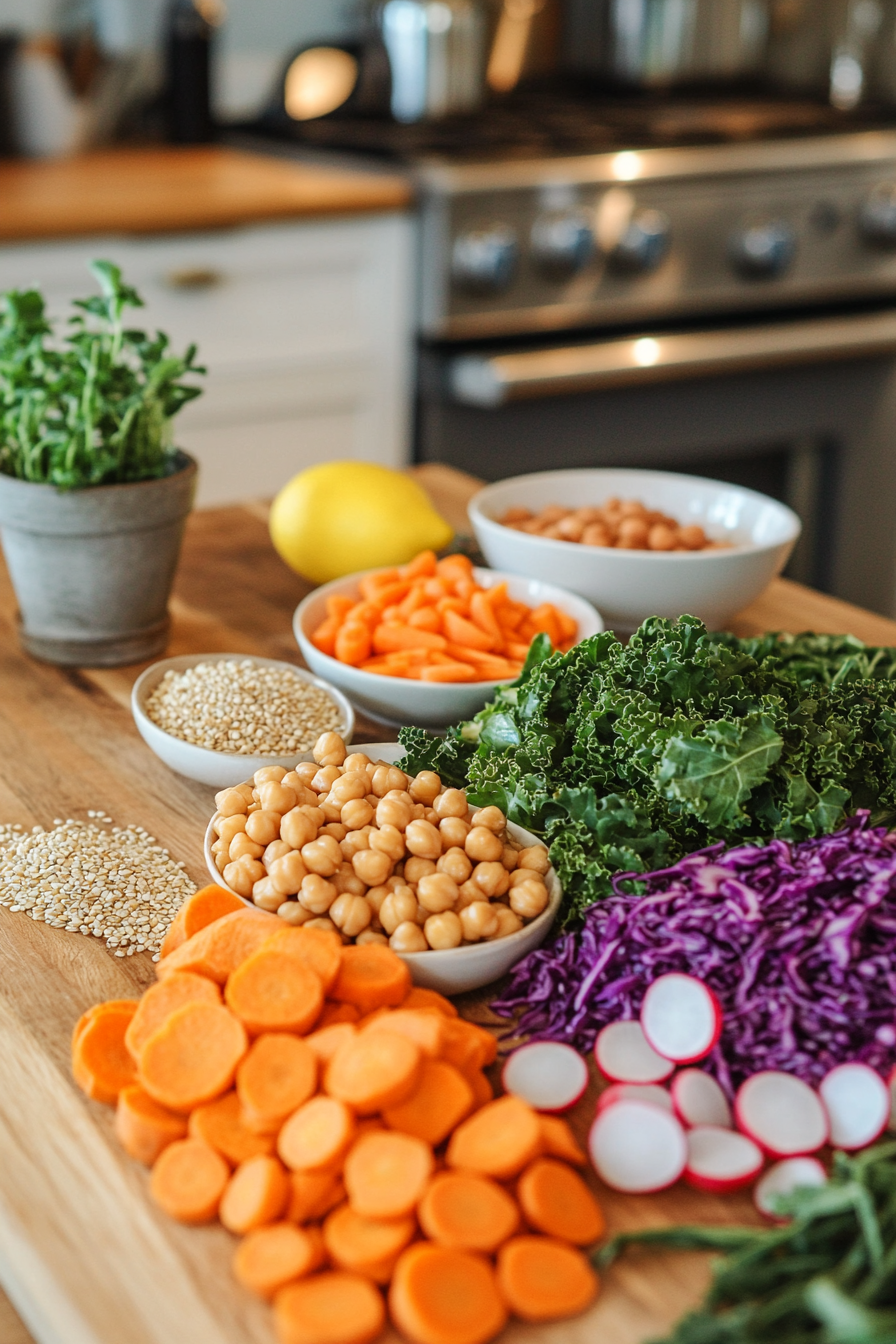
Essential Ingredients for buddha bowl
The success of this buddha bowl depends on the quality and combination of fresh, wholesome ingredients. Below is a detailed list with exact measurements, including notes on vegan, gluten-free, and low-calorie options where applicable:
| Ingredient | Quantity | Notes/Benefits |
|---|---|---|
| Sweet Potato | 1 large | Rich in beta-carotene, fiber, and naturally gluten-free |
| Olive Oil | 2 tablespoons | Healthy monounsaturated fats for roasting and flavor |
| Watermelon Radish or Red Radish | 1 medium | Fresh crunch and mild spice, adds color |
| Carrots | 2 medium | Vitamin A source, peeled into ribbons for texture |
| Shredded Red Cabbage | 1 cup | High in fiber and antioxidants, contributes crunch |
| Lemon Juice | 3 tablespoons (divided) | Brightens flavors and softens kale |
| Kale (Tuscan or Curly) | 1 cup, massaged | Excellent vitamin and mineral profile |
| Cooked Brown Rice or Quinoa | 1 cup | Provides complex carbs; quinoa is higher in protein and gluten-free |
| Chickpeas or Other Legume | 1 cup, cooked or canned | Great plant protein source; can be sautéed with cumin and oregano for flavor |
| Sauerkraut | ¼ cup | Adds probiotics and tangy flavor |
| Sesame or Hemp Seeds | 2 tablespoons | Healthy fats and nutty crunch |
| Microgreens (Optional) | ¼ cup | Boosts nutrient density and freshness |
Additional Flavor Enhancers:
- Turmeric Tahini Sauce (made from tahini, maple syrup, lemon juice, and hot water)
- Spices like cumin and oregano for chickpeas
- Roasted broccolini or other seasonal vegetables as variations
This thoughtfully selected ingredient list covers the needs of vegan, gluten-free, and low-calorie diners, making this buddha bowl a flexible and healthful choice anytime.
For a variety of other wholesome recipes, visit Valentina Recipes homepage.
Dietary Substitutions to Customize Your Buddha Bowl
Buddha bowls are wonderfully versatile, making them easy to customize according to dietary preferences and ingredient availability. Whether you follow a vegan, gluten-free, or other specialized diet, simple substitutions can keep your bowl nutritious and delicious without compromising on flavor or texture.
Substitutions for Various Dietary Needs
- Sweet Potato Alternatives: If you dislike sweet potatoes or want variety, swap them for roasted butternut squash or cauliflower florets. These options provide similar textures and absorb seasonings well.
- Grain Options: Brown rice and quinoa are popular, but barley, millet, or buckwheat make excellent gluten-free or whole grain substitutes depending on your taste or dietary restrictions.
- Protein Choices: Chickpeas add plant-based protein, but you can also use cooked lentils, black beans, or even grilled tofu for a vegan-friendly protein boost. For non-vegans, shredded chicken or boiled eggs work well.
- Leafy Greens Substitutes: Kale is a nutrient powerhouse, but spinach, Swiss chard, or collard greens can provide a softer texture or milder flavor depending on preference.
- Fermented Ingredients: Sauerkraut can be replaced with kimchi or pickled radishes, adding similar tang and healthy probiotics.
- Seed and Nut Toppings: Sesame or hemp seeds can be swapped for pumpkin seeds, sunflower seeds, or chopped nuts like almonds or walnuts for added crunch and nutrition.
- Dressing Options: The turmeric tahini sauce is delicious and creamy, but alternatives include lemon vinaigrette, avocado dressing, or a simple olive oil and balsamic combo to suit dietary needs or flavor preferences.
These substitutions not only cater to allergies or dietary preferences but also allow you to experiment with seasonal produce and pantry ingredients, keeping your buddha bowl exciting and fresh. For more creative recipes that emphasize whole foods and balanced nutrition, check out this Shrimp and Cucumber Salad Recipe.
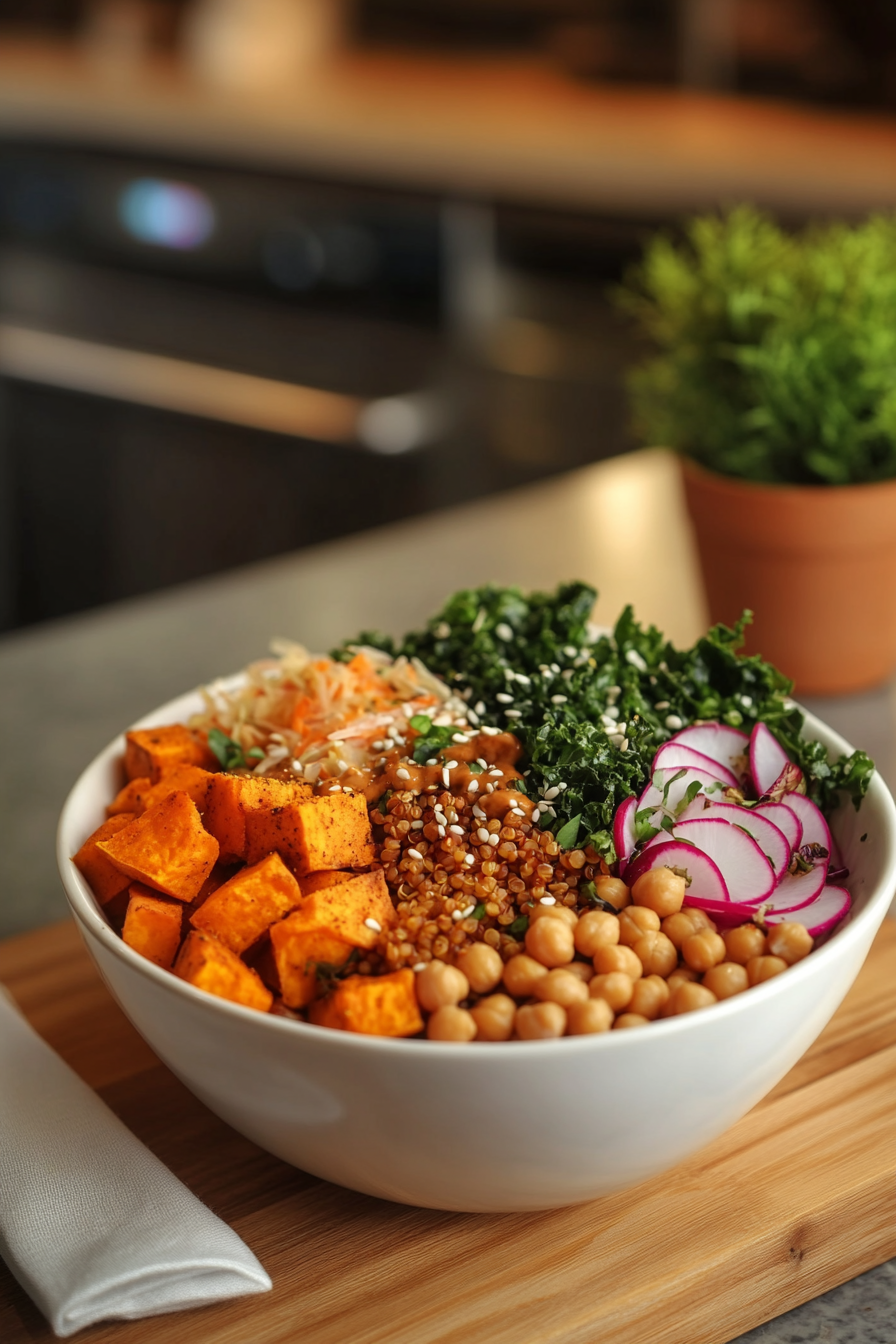
How to Prepare the Perfect Buddha Bowl: Step-by-Step Guide
First Step: Prepare and Roast the Sweet Potato
Preheat your oven to 400 degrees Fahrenheit (about 200 degrees Celsius). Peel and chop one large sweet potato into cubes. Toss these cubes in 1 to 2 tablespoons of olive oil, sprinkle with salt and pepper, and spread them evenly on a baking sheet. Roast in the oven for approximately 20 minutes, or until tender and caramelized. This roasting adds a natural sweetness and texture contrast to your bowl.
Second Step: Prepare the Fresh Vegetables
While the sweet potatoes are roasting, prepare the fresh vegetables:
- Thinly slice one watermelon radish or red radish for crisp color and a mild peppery taste.
- Peel two medium carrots into ribbons using a vegetable peeler.
- Shred about one cup of red cabbage and toss it with the carrot ribbons and radishes in a bowl. Drizzle with 1 tablespoon of fresh lemon juice to brighten the flavors and lightly season with salt.
Third Step: Massage the Kale
Take about 2 cups of kale leaves, remove the tough stems, and roughly chop. Place in a bowl, drizzle with 1 tablespoon of lemon juice and a pinch of salt, then massage with your hands for about 2 minutes until the leaves soften and darken. This process breaks down the kale’s fibrous texture, making it easier to eat and digest. To learn more about preparing and using kale, see this resource on How to Cook and Use Kale for Better Nutrition.
Fourth Step: Cook the Grain Base
Cook 1 cup of brown rice or quinoa according to package instructions. Both options provide a hearty, complex carbohydrate base that will make your buddha bowl filling and nutritious. Once cooked, fluff with a fork and keep warm.
Fifth Step: Prepare the Chickpeas or Legumes
You can use canned chickpeas or cook your own. For extra flavor, sauté 1 cup of chickpeas in a pan with 1 tablespoon olive oil, 1 teaspoon cumin, ½ teaspoon oregano, salt, and pepper until lightly browned and crisp on the edges. This adds a delightful texture and aromatic spices.
Sixth Step: Assemble the Bowl
Layer the ingredients in individual serving bowls:
- A base of cooked brown rice or quinoa.
- A generous scoop of sautéed or plain chickpeas.
- The massaged kale arranged on one side.
- The carrot, radish, and cabbage slaw on another side.
- The roasted sweet potatoes placed prominently.
- A spoonful of sauerkraut on top for tang and probiotics.
- Sprinkle with sesame seeds or hemp seeds and add microgreens if available.
Seventh Step: Make the Turmeric Tahini Sauce
Whisk together the following until smooth:
- 3 tablespoons tahini
- 1 tablespoon maple syrup
- 1 tablespoon fresh lemon juice
- ½ teaspoon ground turmeric
- Hot water as needed to reach a drizzling consistency (start with 1 tablespoon)
Drizzle this sauce generously over the assembled bowl just before serving for creamy, bright, and spicy notes that tie all the elements together.
Summary Table: Cooking Times and Temperatures
| Ingredient | Preparation | Cooking Time | Temperature |
|---|---|---|---|
| Sweet Potato | Peel, cube, toss with oil | 20 minutes | 400° F / 200° C |
| Brown Rice or Quinoa | Rinse and cook | 15-20 minutes | Simmer on stovetop |
| Chickpeas (optional sauté) | Drain and sauté with spices | 5-7 minutes | Medium heat |
The total preparation and cooking time takes about 35 to 40 minutes, making this a quick and satisfying meal option. For more balanced grain bowls, visit this Ground Beef Rice Burrito Bowls recipe that also offers great layering techniques.
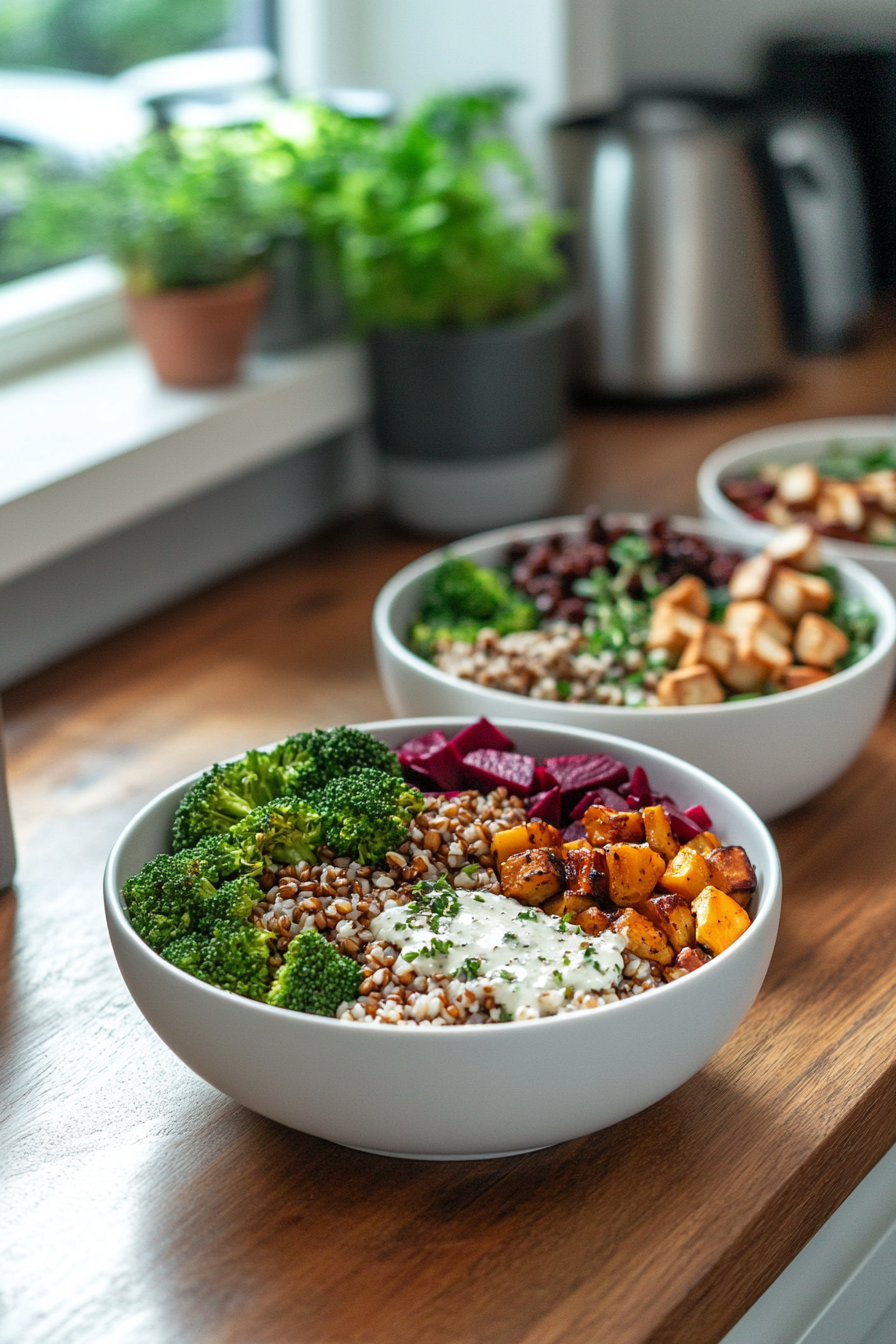
Mastering Buddha Bowl: Advanced Tips and Variations
Tips to Perfect Your Buddha Bowl
- Balance textures and flavors. Combine crunchy elements like radishes and cabbage with creamy and soft items such as avocado or sweet potatoes to keep each bite exciting.
- Layer thoughtfully. Place heavier ingredients like grains and legumes at the bottom, with delicate greens and toppings above to maintain texture and presentation.
- Season as you go. Lightly season individual components rather than the whole bowl to avoid sogginess and maintain distinct flavors.
- Massage kale thoroughly. Properly massaged kale loses bitterness and toughness, making it much more enjoyable to eat.
Variations to Try
- Different roasted vegetables. Try broccolini, Brussels sprouts, or roasted beets for variety and nutritional benefits.
- Alternative grains. Swap quinoa for millet or barley for subtle differences in texture and taste.
- Sauces and dressings. Besides turmeric tahini, experiment with green goddess dressing, miso-ginger sauce, or a spicy peanut sauce for diverse flavor profiles.
- Protein swaps. Use grilled tempeh, baked tofu, or seasoned ground turkey for additional protein options that fit different tastes.
“Versatility is the hallmark of the perfect buddha bowl – endless ingredient combinations encourage creativity and make mealtime enjoyable.”
These ideas empower you to craft personalized bowls that fit your taste buds and nutritional goals. For more inspiration on versatile vegetable mains, consider this Garlic Broccoli Stir Fry recipe that can double as a hearty bowl ingredient.
How to Store Buddha Bowl: Best Practices
Proper storage preserves the fresh flavors and textures of your buddha bowl ingredients, ensuring they remain tasty and safe to eat for days after preparation.
Refrigeration
- Store cooked grains, roasted sweet potatoes, and prepared legumes in separate airtight containers in the refrigerator. These components typically keep well for 3 to 4 days.
- Keep fresh vegetables like shredded cabbage and carrot ribbons in a separate container to maintain crispness.
- Avoid mixing sauerkraut or other fermented items with wet ingredients before serving to prevent sogginess and maintain probiotic benefits.
Freezing
While most boddha bowl components are best fresh, cooked grains and roasted sweet potatoes freeze well. Store in freezer-safe containers for up to 2 months. Thaw overnight in the refrigerator before reheating.
Reheating Tips
- Reheat grains and roasted vegetables in the microwave or a skillet until warm, adding a splash of water to prevent drying.
- Fresh vegetables and toppings are best added after reheating to retain texture and flavor.
- Dress the bowl just before eating to avoid soggy ingredients.
By preparing some elements ahead and storing them properly, you can enjoy quick and nutritious meals throughout your week without sacrificing quality or taste.
Nutritional Value of Buddha Bowl
This Buddha Bowl combines a balanced mix of carbohydrates, plant-based protein, healthy fats, and fiber, making it both nourishing and satisfying. Below is an approximate breakdown of nutrients per serving based on a bowl prepared with the recommended ingredients.
| Nutrient | Amount per Serving | Daily Value (%) |
|---|---|---|
| Calories | 430 kcal | 22% |
| Carbohydrates | 65 g | 22% |
| Dietary Fiber | 12 g | 48% |
| Protein | 15 g | 30% |
| Total Fat | 10 g | 15% |
| Saturated Fat | 1.5 g | 8% |
| Vitamin A | 350% DV | |
| Vitamin C | 90% DV | |
| Iron | 20% DV |
The high fiber content from vegetables, grains, and legumes supports digestive health, while the healthy fats from olive oil, tahini, and seeds promote heart health. Sweet potatoes contribute beta-carotene and antioxidants. For more on the benefits of sweet potatoes, visit Health Benefits of Sweet Potatoes.
This recipe is naturally vegan and can be easily adapted to be gluten-free by choosing gluten-free grains like quinoa or millet. It’s a balanced meal perfect for anyone seeking a wholesome, flavorful dish.
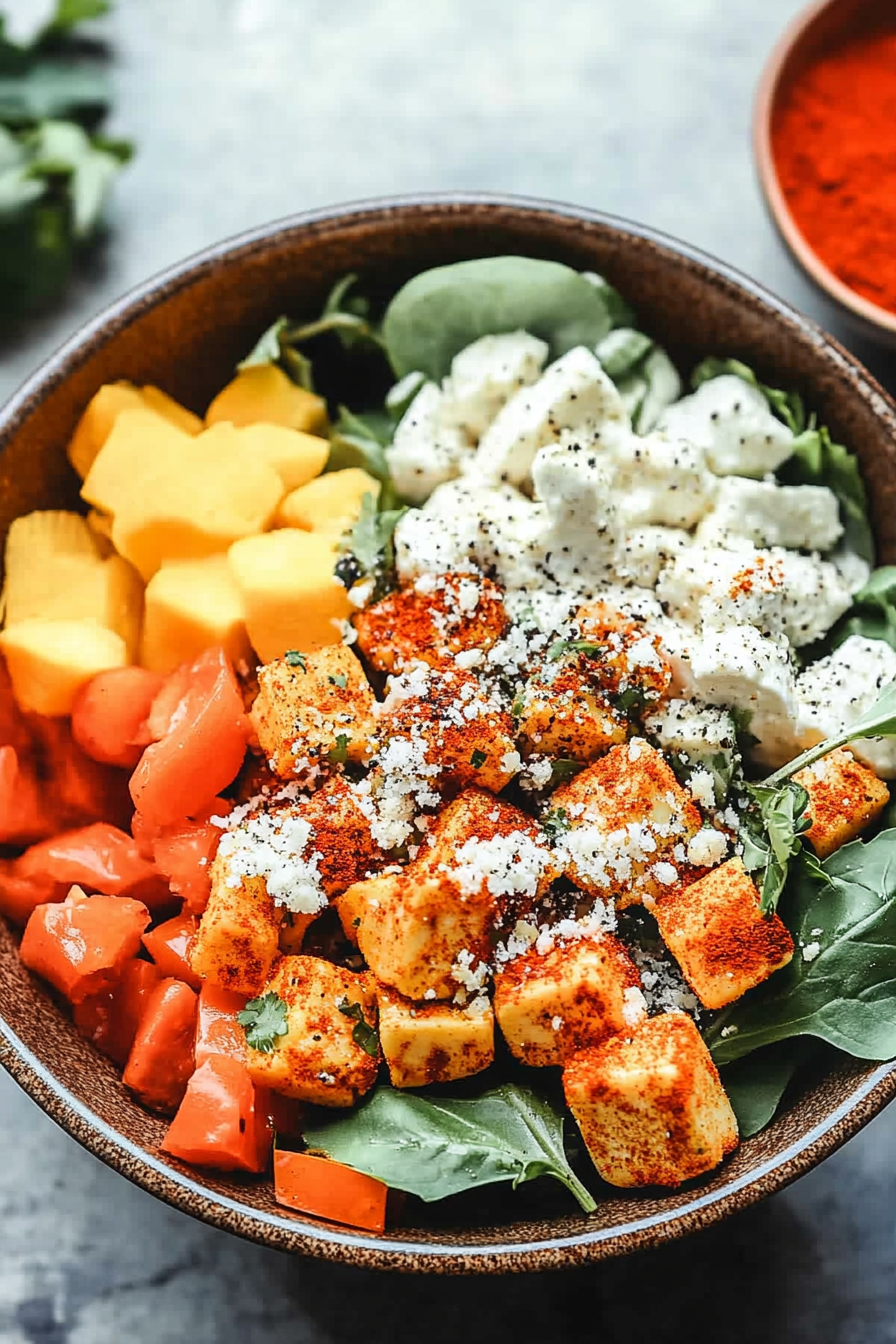
FAQs: Frequently Asked Questions About Buddha Bowl
What is a Buddha Bowl and what does it contain?
A Buddha Bowl is a wholesome, one-bowl meal featuring a balanced mix of grains, vegetables, and plant-based proteins such as beans or tofu. It often includes toppings like nuts, seeds, and fresh herbs and is served with a flavorful sauce.
Why is it called a Buddha Bowl?
The name is thought to be inspired by Buddha’s alms bowl filled with a variety of small food portions, symbolizing abundance. The bowl also appears rounded and full, reminiscent of Buddha’s belly.
How can I customize my Buddha Bowl?
You can customize by swapping grains, proteins, and vegetables to suit taste or dietary preferences. For example, use barley instead of quinoa or tofu instead of chickpeas. Dressings can also be varied to match flavor preferences.
How do you make chickpeas crispy for Buddha Bowls?
To make crispy chickpeas, sauté them in olive oil with spices like cumin and oregano over medium heat until golden and slightly crispy. You can also roast them in the oven after tossing with oil and seasonings.
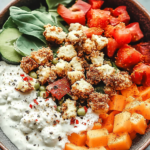
Top Buddha Bowl Recipes: Sweet Potato & Chickpea Creations for a Flavorful Meal
- Total Time: 40 minutes
- Yield: 2 bowls 1x
- Diet: Vegan
Description
🥗 Discover the vibrant flavors of our Buddha Bowl, offering a hearty and nutritious meal in a bowl. Perfect for those seeking a balanced diet with flavor-packed ingredients.
Ingredients
1 large sweet potato
Olive oil
Salt
Pepper
1 watermelon or red radish
2 medium carrots
Shredded red cabbage
Lemon juice
Kale
Cooked brown rice or quinoa
Chickpeas or another legume
Sauerkraut
Sesame or hemp seeds
Optional microgreens
Instructions
1. Preheat your oven to 400 degrees Fahrenheit.
2. Cut the sweet potato into chunks and toss with olive oil, salt, and pepper.
3. Roast the sweet potatoes in the oven for about 20 minutes until they’re soft and golden.
4. Thinly slice the radish and peel the carrots into ribbons.
5. In a large mixing bowl, combine shredded red cabbage, radish slices, carrot ribbons, and a splash of lemon juice.
6. Massage the kale with lemon juice and salt until it softens.
7. Layer cooked brown rice or quinoa in individual serving bowls.
8. Add the roasted sweet potatoes and legumes on top of the grains.
9. Arrange the prepared vegetables and massaged kale over the legumes.
10. Finish by topping each bowl with sauerkraut and sesame or hemp seeds.
11. Drizzle with turmeric tahini sauce and garnish with optional microgreens before serving.
Notes
🌿 Tip: Prepare components like rice, legumes, and vegetables in advance for quick assembly during meal times.
🍋 Tip: For an extra zesty kick, adjust the lemon juice amount in your sauce and veggie mix to suit your taste.
🌱 Tip: Swap out ingredients like sweet potatoes for butternut squash or quinoa for barley for exciting variations.
- Prep Time: 15 minutes
- Cook Time: 20 minutes
- Cook Time: 5 minutes
- Category: Main Course
- Method: Roasting, Layering
- Cuisine: Fusion
Nutrition
- Serving Size: 1 bowl
- Calories: 395
- Sugar: 8g
- Sodium: 540mg
- Fat: 14g
- Saturated Fat: 2g
- Unsaturated Fat: 10g
- Trans Fat: 0g
- Carbohydrates: 57g
- Fiber: 10g
- Protein: 12g
- Cholesterol: 0mg

